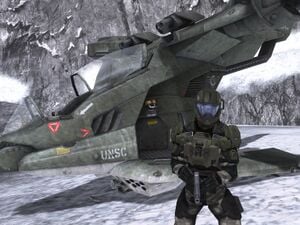| This article does not have enough inline citations and/or does not adhere to the proper citation format. You can help Halopedia by adding citations. |
Template:FOF-1 Template:SeeWikipedia

A pilot is a person, typically of a military service, that can operate and maneuver an airborne, or space-borne vehicle.
Covenant
A surprisingly large number of Covenant species possess the intelligence necessary to pilot craft. Groups of Jiralhanae or Sangheili can operate a space borne Covenant ship, such as the CCS-class battlecruiser or the Reverence-class cruiser, by operation of holographic consoles at the control bridge of the warship. Huragok also help in the technical maintenance of warship systems, although it is unknown if they can pilot and operate the actual warship itself. A single Brute or Elite can also pilot Phantom or Spirit dropships.
Elites and Brutes can pilot a single person Banshee attack fighter. Grunts are also known to be able to pilot Banshees, albeit clumsily. It is unknown how they fit inside the Banshee's cockpit with a methane tank on as it is never seen in-game, it is mentioned only once, in Halo: The Flood. It may be possible that the Banshees that Grunts operate are customized to fit their particular anatomy, but there is no evidence to suggest this.
Elite pilots have their own Flight Suit for operations in a variety of airborne vessels. It is unknown, but likely, that Brutes have an equivalent.
Vehicles used by Covenant pilots
Dropships
Fixed Wing
Other
United Nations Space Command
There are pilots in all main branches of the UNSC Defense Force: the Air Force, Navy, and the Marine aviators of the Marine Corps. Large crews of Navy crewmen operate and maintain UNSC starships such as Marathon-class cruisers. GA-TL1 Longswords, Sparrowhawks, Hornets and Pelican dropships can all be operated by just one Navy pilot, as can Bumblebee lifepods.
It is seen that the Pelicans of the UNSC Pillar of Autumn are exclusively operated by two pilots from 23rd Naval Air Squadron, while the Pelicans of the UNSC In Amber Clad are operated by Marine pilots.
UNSC Air Force pilots wear fatigues with teal-toned camouflage and white chest armor. The suit lacks the additional armor plating worn by most Army troopers or Marines on the knees and shoulders. On missions in a vacuum, the suit can be sealed off and an enclosed standard combat helmet is worn with it.[1][note 1] Additionally, a type of helmet has been specifically developed for UNSC Air Force pilots. This helmet is presumably used in normal missions while the combat helmet is worn on operations where direct combat, such as boarding action, is expected.
While only select UNSCDF personnel operate space-borne and airborne craft, all marines of the UNSC Marine Corps are seen to demonstrate prowess in operating all UNSC ground vehicles - Scorpions, Warthogs, and Mongooses, and even the Covenant Ghost as well. ODSTs also operate their own Single Occupant Exoatmospheric Insertion Vehicles.
During October 2552, Marine Dropship pilots wore ballistic helmets with a golden visor and an integrated communications system. The rest of the outfit is the same as that of the Marine infantrymen. In November 2552, Marine pilots were seen wearing the same body armor as that of a Marine but with a sealed helmet with a blue visor reminiscent of a modern fighter pilot's helmet. The chest armor is also equipped with an additional control panel.
It takes 1,000,000 cR to train a pilot, such as the education, flight simulation training, the written tests, fuel and the plane itself, not to mention the taxes that are paid to keep the service working.[citation needed]
In Halo: Reach, UNSC Sabre Pilots wear standard Army Trooper uniform, with a Military Police helmet and an air supply. These pilots' suits let them survive in space for a short period.
Vehicles used by UNSC pilots
Dropships
Fixed-wing
Gunships
VTOL
Other
Named dropships/fighters with mentioned pilots
- Bravo 001 -Flight Officer Mitchell - KIA
- Bravo 022- KIA
- Charlie 217 -Lieutenant Rick Hale - KIA
- Echo 136 -Lieutenant Peterson - KIA
- Echo 206 -Petty Officer Second Class Polaski - KIA
- Echo 419 -Captain Carol "Foehammer" Rawley - KIA + Lieutenant Frye - KIA + Crew Chief Cullen - KIA
- Kilo 023 -Hocus - active service
- Victor 933 - Active service although pelican was destroyed
- Knife 26 - (Not Mentioned), most likely KIA
Trivia
- In Halo 3, the UNSC pilot helmet is not sealed properly, which can be seen when the player looks underneath their helmets.
- In Halo 3, the pilot's helmets are invulnerable to any projectile.
- Halo 2's pilots wear helmets strongly reminiscent of the Cyborg's helmet from Bungie's earlier Marathon series of first-person shooter games.
- If a VTOL pilot is infected by the Flood in Halo 3, they will take on the appearance of a standard Marine, not a pilot variation.
- In Halo: Reach, the armor permutations include the UNSC Air Force Pilot helmet.
Gallery
A transparent scan of the UNSC Pilot of Halo 3, from the Halo Encyclopedia.
- 1203637899 18824417-Medium.jpg
A close up of a UNSC VTOL Pilot.
- 028.jpg
A group of Marines, one of them wearing a pilot uniform.
- Boarder.jpg
An UNSC Air Force pilot boarder.
- Pilot hul-3.jpg
The UNSC Air Force pilot helmet, compatible with the MJOLNIR armor.
Notes
Sources
- ^ Halo: Reach, campaign levels Tip of the Spear, Long Night of Solace
